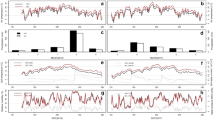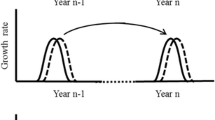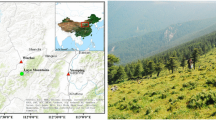Abstract
Key message
A fixed sequence existed in the timing of critical stages between apical and radial growth. Radial growth was highly correlated with apical growth during the onset stage but not during the peak or cessation stages.
Abstract
The temporal relationships between the apical and radial growth of conifers may vary with species and site, and the varied responses of growth to climate change have rarely been revealed. We studied the temporal sequences and correlations between the apical and radial growth of Picea meyeri and the responses of the two growth types to the short-term climate of Luya Mountain, North-central China. The seasonal dynamics of aboveground growth at three sites were monitored, and the climate conditions of two growing seasons were contrasted. The results showed that (1) stem growth was initiated first, followed by needle and shoot growth; stem growth peaked and ceased last, followed by shoot growth and then needle growth, regardless of site or year. Stem growth was highly correlated with needle and shoot growth during the onset stage but not during the peak or cessation stages. (2) The three organs showed a similar earlier growth onset and peak in the warmer year (2017) than in the colder year (2016), although consistent earlier growth cessation was not observed, and growth increments were not significantly greater in the former than in the latter. Stem growth showed a longer duration, lower relative rate, and larger increment variability than shoot and needle growth, irrespective of site and year. These results suggested that (1) there was a consistent temporal sequence of the timing of critical growth periods between apical and radial growth (radial growth was not always linked to apical growth, at least during the peak and cessation growth periods) and (2) the three organs did not show consistent phenological responses to temperature during the growth cessation stage. Neither apical nor radial growth was enhanced by short-term warming; radial growth was probably more susceptible than apical growth to climate change.






Similar content being viewed by others

References
Aloni R (2001) Foliar and axial aspects of vascular differentiation: hypotheses and evidence. J Plant Growth Regul 20:22–34
Antonucci S, Rossi S, Deslauriers A, Lombardi F, Marchetti M, Tognetti R (2015) Synchronisms and correlations of spring phenology between apical and lateral meristems in two boreal conifers. Tree Physiol 10:1086–1094
Begum S, Nakaba S, Oribe Y, Kubo T, Funada R (2007) Induction of cambial reactivation by localized heating in a deciduous hardwood hybrid poplar (Populus sieboldii × P. grandidentata). Ann Bot Lond 100:439–447
Begum S, Nakaba S, Yamagishi Y, Oribe Y, Funada R (2013) Regulation of cambial activity in relation to environmental conditions: understanding the role of temperature in wood formation of trees. Physiol Plant 147:46–54
Cartenì F, Deslauriers A, Rossi S, Morin H, De Micco V, Mazzoleni S, Giannino F (2018) The physiological mechanisms behind the earlywood-to-latewood transition: a process-based modeling approach. Front Plant Sci 9:1–12
Čufar K, Peter P, de Luis M (2008) Tree-ring variation, wood formation and phenology of beech (Fagus sylvatica) from a representative site in Slovenia, SE Central Europe. Trees Struct Funct 22:749–758
Cuny HE, Rathgeber CB, Lebourgeois F, Fortin M, Fournier M (2012) Life strategies in intra-annual dynamics of wood formation: example of three conifer species in a temperate forest in north-east France. Tree Physiol 32:612–625
Delpierre N, Vitasse Y, Chuine I, Guillemot J, Bazot S, Rutishauser T, Rathgeber CBK (2016) Temperate and boreal forest tree phenology: from organ-scale processes to terrestrial ecosystem models. Ann For Sci 73:5–25
Deslauriers A, Morin H, Begin Y (2003) Cellular phenology of annual ring formation of Abies balsamea in the Quebec boreal forest (Canada). Can J For Res 33:190–200
Dobbertin M, Eilmann B, Bleuler P, Giuggiola A, Pannatier EG, Landolt W et al (2010) Effect of irrigation on needle morphology, shoot and stem growth in a drought-exposed Pinus sylvestris forest. Tree Physiol 30:346–360
Gruber A, Strobl S, Veit B, Oberhuber W (2010) Impact of drought on the temporal dynamics of wood formation in Pinus sylvestris. Tree Physiol 30:490–501
Heinrich S, Dippold MA, Werner C, Wiesenberg GL, Kuzyakov Y, Glaser B (2015) Allocation of freshly assimilated carbon into primary and secondary metabolites after in situ 13C pulse labelling of Norway spruce (Picea abies). Tree Physiol 35:1176–1191
Hoch G, Körner C (2005) Growth, demography and carbon relations of Polylepis trees at the world’s highest treeline. Funct Ecol 19:941–951
Huang JG, Bergeron Y, Zhai L, Denneler B (2011) Variation in intra-annual radial growth (xylem formation) of Picea mariana (Pinaceae) along a latitudinal gradient in western Quebec, Canada. Am J Bot 98:792–800
Huang JG, Deslauriers A, Rossi S (2014) Xylem formation can be modeled statistically as a function of primary growth and cambium activity. New Phytol 203:831–841
Jackson SD (2008) Plant responses to photoperiod. New Phytol 181:517–531
Jiang Y, Zhang Y, Guo Y, Kang M, Wang M, Wang B (2015) Intra-annual xylem growth of Larix principis-rupprechtii at its upper and lower distribution limits on the Luyashan mountain in North-Central China. Forests 6:3809–3827
Körner C (2012) Alpine Treelines: functional ecology of the global high elevation tree limits. Springer, Basel
Little CHA, Wareing PF (1981) Control of cambial activity and dormancy in Picea sitchensis by indol-3-ylacetic and abscisic acid. Can J Bot 59:1480–1493
Minchin PEH, Lacointe A (2005) New understanding on phloem physiology and possible consequences for modelling long-distance carbon transport. N Phytol 166:771–779
Moser L, Buentgen U, Franzen J, Esper J, Luterbacher J, Franzen J (2010) Timing and duration of European larch growing season along altitudinal gradients in the Swiss Alps. Tree Physiol 30:225–233
National Soil Survey Office (1995) Annals of soil species in China. China Agriculture Press, Beijing (in Chinese)
Nord E, Lynch JP (2009) Plant phenology: a critical controller of soil resource acquisition. J Exp Bot 60:1927–1937
Oleksyn J, Zytkowiak R, Karolewski P, Reich PB, Tjoelker MG (2000) Genetic and environmental control of seasonal carbohydrate dynamics in trees of diverse Pinus sylvestris populations. Tree Physiol 20:837–847
Oribe Y, Funada R, Kubo T (2003) Relationships between cambial activity, cell differentiation and the localization of starch in storage tissues around the cambium in locally heated stems of Abies sachalinensis (Schmidt) Masters. Trees Struct Funct 17:185–192
Pan Y, Birdsey RA, Fang J, Houghton R, Kauppi PE, Kurz WA et al (2011) A large and persistent carbon sink in the world’s forests. Science 333:988–993
Perrin M, Rossi S, Isabel N (2017) Synchronisms between bud and cambium phenology in black spruce: early-flushing provenances exhibit early xylem formation. Tree Physiol 37:593–603
Rathgeber CB, Rossi S, Bontemps JD (2011) Cambial activity related to tree size in a mature silver-fir plantation. Ann Bot Lond 108:429–438
Ren P, Rossi S, Camarero J, Liang E, Cufar K (2015) Is precipitation a trigger for the onset of xylogenesis in Juniperus przewalskii on the north-eastern Tibetan Plateau? Ann Bot Lond 115:629–639
Rossi S, Deslauriers A, Anfodillo T, Morin H, Saracino A, Motta R (2006) Conifers in cold environments synchronize maximum growth rate of tree-ring formation with day length. N Phytol 170:301–310
Rossi S, Rathgeber CBK, Deslauriers A (2009) Comparing needle and shoot phenology with xylem development on three conifer species in Italy. Ann For Sci 66:1–8
Rossi S, Girard MJ, Morin H (2014) Lengthening of the duration of xylogenesis engenders disproportionate increases in xylem production. Glob Change Biol 20:2261–2271
Savidge RA (2001) Intrinsic regulation of cambial growth. J Plant Growth Regul 20:52–77
Schmitt U, Möller R, Eckstein D (2000) Seasonal wood formation dynamics of beech (Fagus sylvatica L.) and blck locust (Robinia pseudoacacia L.) as determined by the “pinning” technique. J Appl Bot 74:10–16
Sundberg B, Little CHA, Cui K, Sandberg G (1991) Level of endogenous indole-3-acetic acid in the stem of Pinus sylvestris in relation to the seasonal variation of cambial activity. Plant Cell Environ 14:241–246
Tang Z, Chambers JL, Guddanti S, Yu S, Barnett JP (1999) Seasonal shoot and needle growth of loblolly pine responds to thinning, fertilisation, and crown position. For Ecol Manage 120:117–130
Vitasse Y, Delzon S, Dufrêne E, Pontailler JY, Louvet JM, Kremer A, Michalet R (2009) Leaf phenology sensitivity to temperature in European trees: do within-species populations exhibit similar responses? Agric For Meteorol 149:735–774
Wang Z, Yang B, Deslauriers A (2015) Intra-annual stem radial increment response of Qilian juniper to temperature and precipitation along an altitudinal gradient in northwestern China. Trees Struct Funct 29:25–34
Wang M, Jiang Y, Dong M, Zhang W, Wang B, Zhang Y et al (2018) The contributions of rate and duration of stem radial increment to annual increments of Picea meyeri in a sub-alpine habitat, North-Central China. Trees Struct Funct 32:1029–1041
Zhai L, Bergeron Y, Huang JG, Berninger F (2012) Variation in intra-annual wood formation, and foliage and shoot development of three major Canadian boreal tree species. Am J Bot 99:827–837
Zhang W, Jiang Y, Dong M, Kang M, Yang H (2012) Relationship between the radial growth of Picea meyeri and climate along elevations of the Luyashan Mountain in North-Central China. For Ecol Manage 265:142–149
Zhang J, Gou X, Pederson N, Zhang F, Niu H, Zhao S (2018a) Cambial phenology in Juniperus przewalskii along different altitudinal gradients in a cold and arid region. Tree Physiol 36:840–852
Zhang J, Gou X, Manzanedo RD, Zhang F, Pederson N (2018b) Cambial phenology and xylogenesis of Juniperus przewalskii over a climatic gradient is influenced by both temperature and drought. Agric For Meteorol 260–261:165–175
Zhang Y, Xu J, Su W, Zhao X, Xu X (2018c) Spring precipitation effects on formation of first row of earlywood vessels in Quercus variabilis at Qinling Mountain (China). Trees Struct Funct 33:457–468
Zhang Y, Jiang Y, Wen Y, Ding X, Wang B, Xu J (2019) Comparing primary and secondary growth of co-occurring deciduous and evergreen conifers in an alpine habitat. Forests 10:574
Zhu XB, Sun SC (2006) Leaf phenology of woody species in deciduous broad-leaved oak forests in Nanjing area, East China. J Plant Ecol 30:25–32 (in Chinese with English abstract)
Acknowledgements
This work was supported by the National Key Research and Development Program of China (Grant number 2018YFA0606101) and the National Natural Science Foundation of China (Grant numbers 41630750 and 41771051). Thanks to these two agencies for the funding. We are also grateful to the commissioning editor and anonymous reviewers who provided scientific comments and constructive suggestions on the manuscript.
Author information
Authors and Affiliations
Contributions
XD and YJ conceived and designed the work, XD, FX and MW collected the data, XD, YJ, YZ and MW analyzed and interpreted the data, XD and XF drafted the manuscript; XD, YJ, MK and HX revised the manuscript.
Corresponding author
Ethics declarations
Conflict of interest
The authors declare that they have no conflict of interest exists.
Additional information
Communicated by E. Liang.
Publisher's Note
Springer Nature remains neutral with regard to jurisdictional claims in published maps and institutional affiliations.
Rights and permissions
About this article
Cite this article
Ding, X., Jiang, Y., Xue, F. et al. Intra-annual growth dynamics of Picea meyeri needles, shoots, and stems on Luya Mountain, North-central China. Trees 35, 637–648 (2021). https://doi.org/10.1007/s00468-020-02065-9
Received:
Accepted:
Published:
Issue Date:
DOI: https://doi.org/10.1007/s00468-020-02065-9



